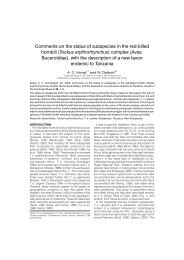EAZA Hornbill Management and Husbandry Guidelines
EAZA Hornbill Management and Husbandry Guidelines
EAZA Hornbill Management and Husbandry Guidelines
Create successful ePaper yourself
Turn your PDF publications into a flip-book with our unique Google optimized e-Paper software.
4 Environmental conditions <strong>and</strong> housing<br />
4.1 Disturbance<br />
Disturbance should be minimized during the beginning of the nesting season, when nestvisiting<br />
<strong>and</strong> sealing in of the female occur. The female is particularly sensitive to<br />
disturbance prior to egg-laying once sealed in the nest (Kemp, 1995). The need to enter<br />
the cage as little as possible during the breeding season should be taken into<br />
consideration in cage design. For example, access to food trays, water faucets, light<br />
switches <strong>and</strong> other environmental controls should be placed outside the enclosure. Plants<br />
<strong>and</strong> perches should be positioned so that the need for enclosure cleaning can be<br />
minimized.<br />
Vegetation around the indoor (part of the) enclosure, with only one side open for public<br />
viewing, is recommended as hornbills housed indoors often share facilities with many<br />
other birds that might disturb them. By their very shape <strong>and</strong> design, walls <strong>and</strong> floors of<br />
indoor aviaries often intensify noise levels, which can frighten the hornbills, particularly<br />
during the breeding season. Vegetation planted in <strong>and</strong> around the enclosure lowers the<br />
noise level <strong>and</strong> enhances the natural appearance of the aviary.<br />
It was noted during nest checks of a great hornbill Buceros bicornis nest at Cotswold<br />
Wild Life Park (UK) that sounds made by visitors seemed to be amplified in the nest,<br />
possibly because of the nest was placed in an area walled on most sides. A hessian barrier<br />
was placed between the visitors <strong>and</strong> the nest (Golding <strong>and</strong> Williams, 1986), with the idea<br />
that this might muffle <strong>and</strong>/or redirect sounds that could be disturbing the hornbills. The<br />
hornbills did nest successfully for the first time thereafter, however it was not possible to<br />
determine whether the barrier played a role in this development (S. Blackwell, pers.<br />
comm.).<br />
Conspecifics, other hornbills or even other avian taxa showing territorial behavior,<br />
especially during the breeding season, should not be housed in aviaries adjoining the<br />
hornbills <strong>and</strong> visual contact should be minimized. For example, fighting between a male<br />
toco toucan Ramphastos toco <strong>and</strong> a Papuan wreathed hornbill Aceros plicatus in adjacent<br />
enclosures at Rotterdam Zoo resulted in loss of the tip of the toucan’s bill. A female great<br />
hornbill Buceros bicornis was injured when she launched herself at a small window<br />
through which she could see a female Papuan wreathed hornbill in winter quarters at the<br />
same institution. Another disturbance problem in addition to aggression can be misdirected<br />
reproductive behaviors: the mate to this female great hornbill had been observed<br />
feeding the female Papuan wreathed hornbill Aceros plicatus through wire-mesh<br />
outdoors.<br />
The effect of vocal/auditory contact is unclear. Bar-pouched wreathed hornbills Aceros<br />
undulatus have been observed to react strongly to play-backs of their own vocalizations<br />
<strong>and</strong> great hornbills Buceros bicornis to tape recording of rhinoceros hornbills (Buceros<br />
rhinoceros at Rotterdam Zoo.<br />
22




